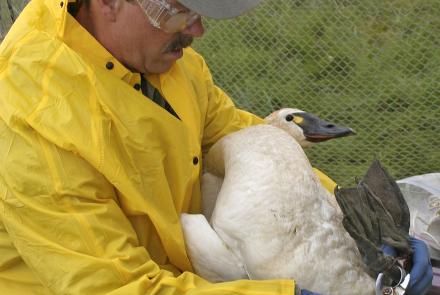Beavers Not Entirely to Blame for Beaver Fever
The last time I went hunting, I brought home more than moose burger. After a day in Fairbanks, I could barely stay awake, and the noises from my abdomen were so loud my dog barked at them. Though I'm always extremely careful about treating my drinking water, I came back to town with an intestinal parasite known commonly as Giardia.
When I told people, everyone offered their own story about Giardiasis, the medical name for the disease. Conflicting stories drove me to the university's biomedical library, where I picked up a book, Giardia and Giardiasis, edited by Stanley Erlandsen of the University of Minnesota and Ernest Meyer of Oregon Health Sciences University. Here's what they told me:
Giardia is the name commonly used to describe several species of one-celled animals that thrive in an airless environment. One of their favorite anaerobic places is in a human's small intestine, near where it connects to the large intestine. Giardia lamblia is the creature that most often knocks humans out for a week or two. It lives in two states-one, the trophozoite, looks sort of like a microscopic teardrop. The trophozoite lives in human and animal intestines, where it divides by binary fission and makes thousands of copies of itself that attach to the lining of the small intestine. Trophozoites, which are so small that dozens of them could line up on the edge of a knife, move with the aid of flagella, first described in 1681 as "sundry little paws" by Anton van Leeuwenhoek, a Giardia sufferer who owned a microscope. Humans pick up the disease by swallowing the resting stage of Giardia, the cyst. Cysts are hardy little tablets that exit an infected animal's body along with feces. Animals known to carry Giardia include dogs, cats, beavers, muskrats and bears, and possibly Dall sheep and moose.
Beavers usually get the rap for spreading Giardia (some people call it Beaver Fever), but William Bemrick, a University of Minnesota researcher, said beavers are blamed far too often. He cited studies on muskrats that showed them to carry even more cysts than beavers that lived nearby. Bemrick also pointed out that infected humans do more than their share of spreading the disease. Three-hundred million cysts may be present in one milligram of human feces, Bemrick wrote, and these cysts can survive for a month in cool water.
Here's a way someone might pick up Giardia: A muskrat with Giardia defecates in the Melozitna River, releasing millions of cysts that are invisible to the naked eye. A science writer motors a canoe, loaded heavy with bags of moose, upstream. River spray comes over the side of the canoe and wets his face. He licks his lips and swallows a few of the cysts. A single cyst makes it to his small intestine, becomes a trophozoite, and begins dividing. In two weeks, enough Giardia have taken up residence to cause a fever, fatigue, and diarrhea.
Though the water route is the most common, Giardia can also be spread by direct contact with feces. In one case tracked by the Minnesota Department of Health, a woman spread Giardia by preparing a meal of salmon after diapering her infected 12-month old grandson. Even though she had washed her hands, researchers figured there were still enough cysts present, perhaps under her fingernails, to infect 31 people.
Once you have Giardia, treatment is usually quick and easy with antibiotics, but in some cases it hangs on for months or years. The best plan is to avoid the parasite, especially in rivers and lakes with beavers and muskrats. Boiling water kills the cysts, and filtering water will also remove them. And if river spray hits you in the face, take these words of advice, also handy in other life situations: Keep your mouth shut.




